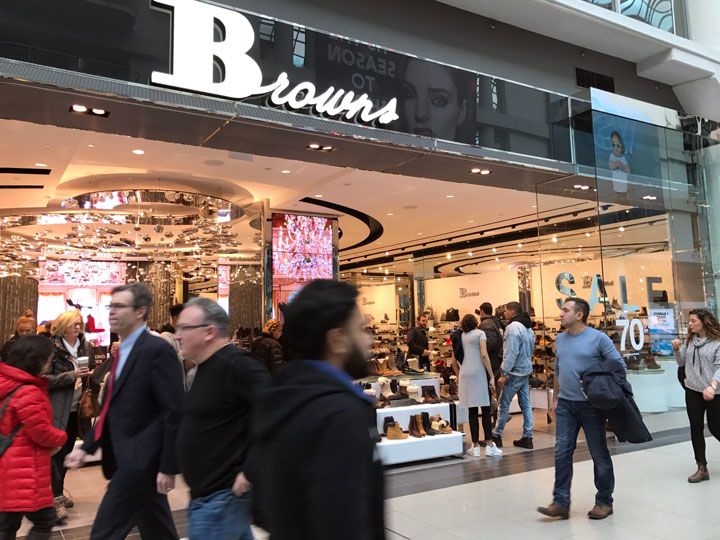In a tough retail landscape, Canada’s biggest malls are thriving, researchers say.

Shopping malls accounted for one-third of Vancouver’s retail sales in 2016, excluding auto dealers and gas stations, according to a study by Statistics Canada published this week. The biggest malls – which the researchers called “super-regional” malls – made $1.9 billion in sales.
This finding surprised Carey Olineck, senior economist at Statistics Canada and the author of the study.
“I found that the sales of the super-regional malls and regional malls were quite high in Vancouver,” he said. He was expecting that “power centres,” outdoor malls with lots of big-box stores connected by parking lots, would be the focus of most sales. These kinds of outlets accounted for only $1.1 billion in sales.
The biggest thing that people are buying at shopping centres is clothing, he found. “Anyone who walks into a regional or super-regional mall, you do see a fair number of clothing retailers.”
Although Olineck’s study focused only on Vancouver, “We don’t think that the trends observed in Vancouver would be any different really than other large Canadian cities,” he said.
Although the retail sector has slower job growth than the rest of the economy, big Canadian malls are doing just fine, according to Craig Patterson, director of applied research at the University of Alberta’s School of Retailing.
“These top shopping centres are still doing really well and a lot of them actually have slightly higher numbers than they did last year, when they were also performing really strongly.”
These malls, like Vancouver’s Pacific Centre, Toronto’s Yorkdale Mall and Eaton Centre and Calgary’s Chinook Centre are often easy to get to and have tried, he thinks, to create an “exciting and interesting experience for the consumer.”
This is in contrast to some smaller, more neighbourhood malls, which he thinks may have declined because of a change in demographics or trends. Several of these are chronicled on the website Deadmalls.com.
Many successful malls in Canada have recently renovated and added new, often luxury stores, said Patterson. With luxury stores, you don’t need many customers to make good sales figures since each item is so expensive. Malls have also revamped their food courts and added more food and beverage options, and sometimes full sit-down restaurants.
“My take on it is landlords are creating community centres, almost like town squares, where people are able to go shop for fashion, meet with their friends and have a meal.”
Some malls are as successful as popular tourist destinations, according to research he did for the Retail Council of Canada last year.
“Toronto Eaton Centre is so busy, it is the busiest mall in North America. It gets as many visitors as Times Square in New York, and it has more visitors than Disneyworld and Disneyland combined.”
Not everyone who goes to the Eaton Centre, which is connected to two subway stops in the busy downtown core, necessarily buys something, he said. But, “This mall is one of the busiest places in the world.”
Online meets bricks-and-mortar
E-commerce is growing – the sector grew by 39.5 per cent in Canada between 2012 and 2015, according to Statistics Canada, while in-store sales only grew by 14.2 per cent.
“In Canada, it’s true that online sales have been growing much more rapidly than in-store sales. But we’ve got to see it in the context that we’re really talking about a very small base of e-commerce sales in retail,” said Olineck.
The Retail Council of Canada estimates that online sales will represent only about eight per cent of retail sales in Canada by the end of the year.
While he thinks that traditional retailers should be concerned by the growth in online sales, Patterson says he’s seen the retail industry adapt in unexpected ways.
“One of the things we’re seeing now is physical retailers are finding that they’re able to drive sales in their stores by having a good website that at least profiles their products and shows what’s available in their stores,” he said.
Some people might order online and have their product shipped to a store to save on shipping costs, which provides an opportunity for the retailer to up sell the customer as they come to pick up their item, he said. And for some things, like fashion, customers often want to try something on in person, even if they eventually order it online.
Successful retailers have a “symbiotic” relationship between their website and storefront, where each drives sales to the other, he said.
And some retailers that were once online-only, like the Frank And Oak clothing store or Warby Parker eyewear, have started to open physical stores.
“That trend is flying in the face of what we thought with e-commerce. We thought that all the stores would close and everybody would shop online,” Patterson said.
“I think to some degree the future of retail is going to be a merger of online and in-store retail.”






Comments